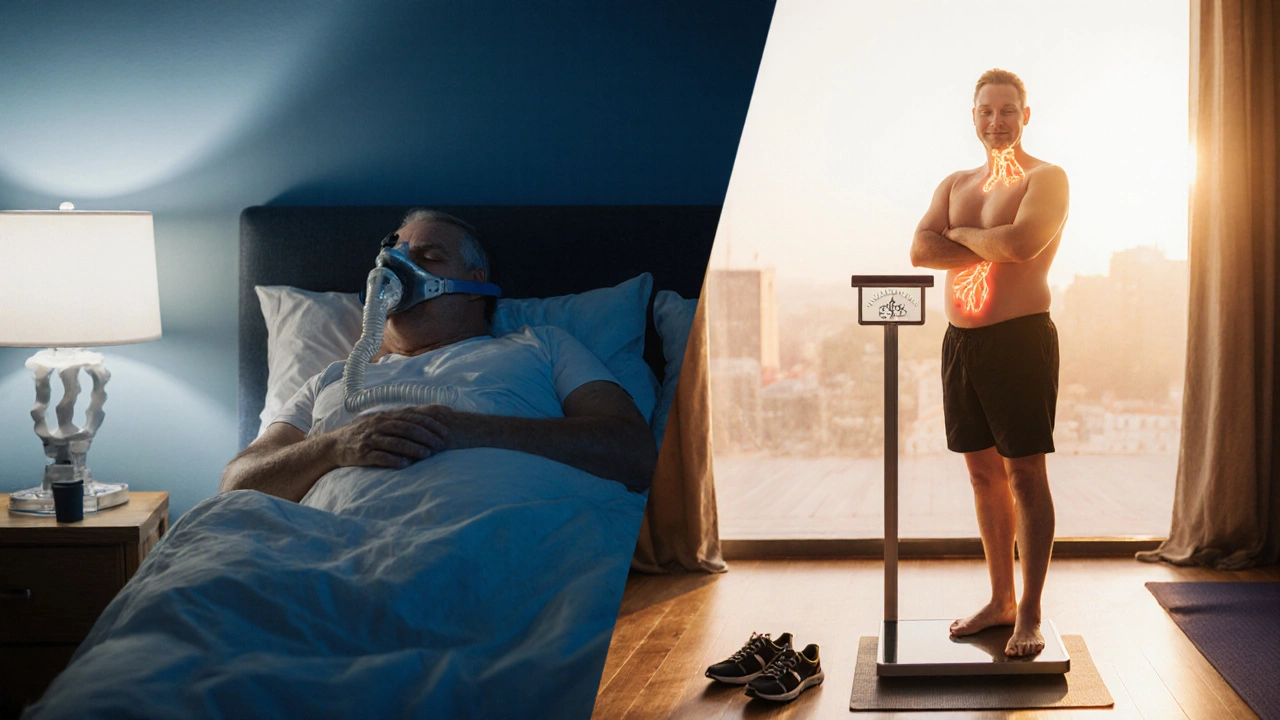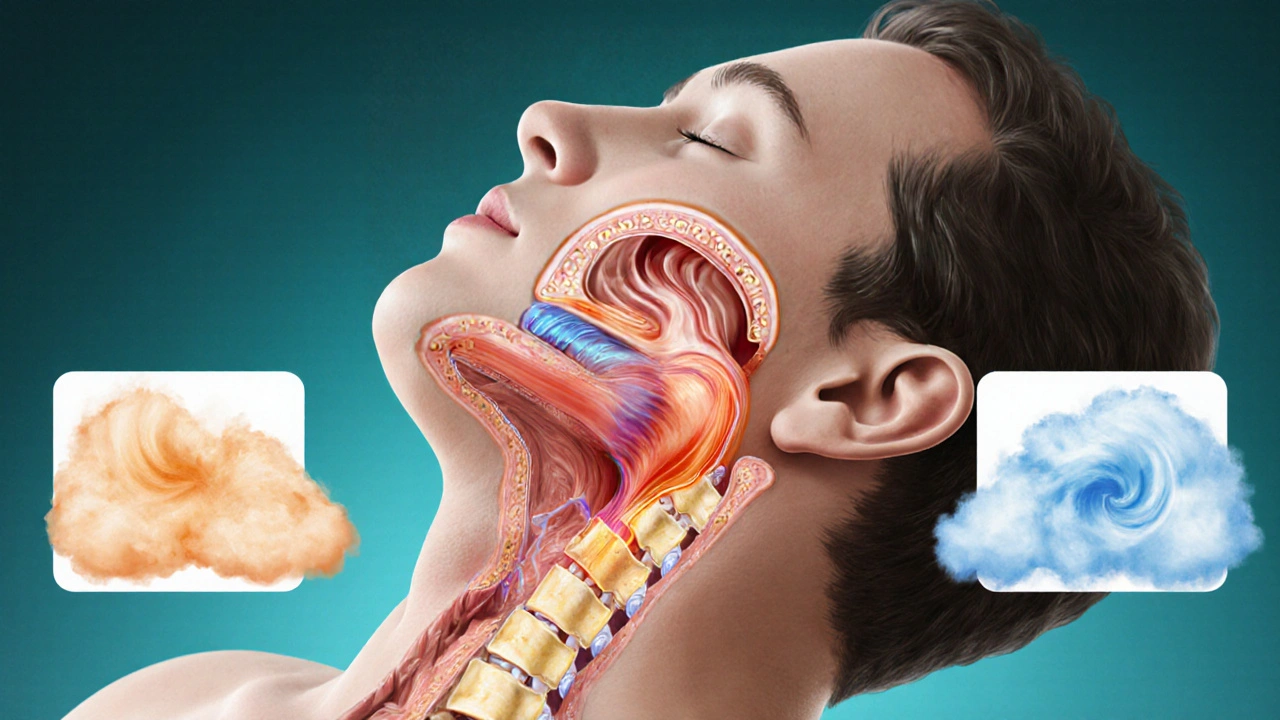Obesity-Sleep Apnea Impact Calculator
Calculate Your Potential Improvement
Enter your current weight and estimated weight loss to see how it could impact your sleep apnea severity and health risks.
Your Results
Impact Comparison Table
| Benefit | Weight Loss (5-10% body weight) | CPAP Therapy |
|---|---|---|
| Average AHI reduction | ~15 events/hour | ~80-90% reduction |
| Improvement in daytime sleepiness | Moderate | High |
| Long-term cardiovascular risk | Decreases as weight falls | Improves quickly, but weight-related risk remains if obesity persists |
| Cost (annual) | Low to moderate (diet, gym) | Medium-high (machine, mask replacements) |
| Adherence challenges | Requires lifestyle change | Mask discomfort, noise |
When Obesity is an excess accumulation of body fat that raises health risks and sleep apnea a sleep‑related breathing disorder causing repeated pauses in airflow occur together, they create a feedback loop that fuels each other. Understanding how these two conditions interact helps you break the cycle before it damages your heart, brain, and overall quality of life.
Why the Two Conditions Feed Each Other
Both obesity and sleep apnea share common physiological pathways. Extra fat around the neck narrows the upper airway, increasing upper airway resistance the force that obstructs airflow during breathing. When the airway collapses during sleep, the brain briefly awakens the person to resume breathing-this is the hallmark of obstructive sleep apnea (OSA). The repeated arousals prevent deep, restorative sleep, which in turn disrupts hormones that control hunger and metabolism.
Sleep‑deprived bodies release more ghrelin the hormone that stimulates appetite and less leptin the hormone that signals fullness. The result? Cravings for high‑calorie foods, slower metabolism, and easier weight gain-making obesity worse, which then aggravates sleep apnea. It’s a classic vicious circle.
Key Health Risks of the Cycle
The combination of excess weight and fragmented sleep spikes the risk of several serious conditions:
- Cardiovascular disease including hypertension, heart attack, and stroke
- Type 2 diabetes because insulin resistance worsens with both obesity and sleep loss
- Metabolic syndrome a cluster of risk factors that raise heart disease and diabetes chances
- Chronic inflammation, which accelerates aging and tissue damage
- Daytime fatigue, cognitive decline, and reduced work performance
How Weight Loss Impacts Sleep Apnea
Numerous studies show that dropping as little as 5-10% of body weight can shrink the airway and lower the apnea‑hypopnea index (AHI)-the metric doctors use to gauge severity. A 2023 meta‑analysis of 22 trials reported an average AHI reduction of 15 events per hour after modest weight loss, enough to shift many patients from severe to mild OSA.
Practical weight‑loss strategies that also improve sleep quality include:
- Adopting a Mediterranean‑style diet rich in vegetables, lean protein, and healthy fats.
- Limiting alcohol and sedatives, which relax throat muscles and worsen apnea.
- Timing meals at least three hours before bedtime to avoid reflux and breathing disturbances.
- Incorporating 150minutes of moderate aerobic activity each week-walking, cycling, or swimming works well.
- Tracking sleep patterns with a wearable or app to identify night‑time awakenings.

Treatment Options Beyond Weight Loss
While shedding pounds helps, many patients need additional therapy to keep breathing steady at night.
- Continuous Positive Airway Pressure (CPAP) a machine that delivers gentle air pressure through a mask to keep the airway open. CPAP is the gold‑standard and can reduce AHI by up to 90% when used correctly.
- Oral appliances that advance the lower jaw, suitable for mild‑moderate cases.
- Surgical options such as uvulopalatopharyngoplasty (UPPP) or mandibular advancement, considered when other treatments fail.
- Managing comorbidities-control blood pressure, treat diabetes, and reduce inflammation with anti‑oxidant‑rich foods.
Quick Takeaways
- Extra neck fat narrows the airway, triggering OSA.
- OSA disrupts hormones, leading to increased appetite and weight gain.
- Even modest weight loss can dramatically lower apnea severity.
- CPAP remains the most effective therapy; lifestyle changes boost long‑term success.
- Addressing both conditions cuts the risk of heart disease, diabetes, and daily fatigue.
Comparison Table: Impact of Weight Management on Sleep Apnea
| Benefit | Weight Loss (5‑10% body weight) | CPAP Therapy |
|---|---|---|
| Average AHI reduction | ~15 events/hour | ~80‑90% reduction |
| Improvement in daytime sleepiness | Moderate | High |
| Long‑term cardiovascular risk | Decreases as weight falls | Improves quickly, but weight‑related risk remains if obesity persists |
| Cost (annual) | Low to moderate (diet, gym) | Medium‑high (machine, mask replacements) |
| Adherence challenges | Requires lifestyle change | Mask discomfort, noise |
When to Seek Professional Help
If you notice any of these warning signs, schedule a sleep study or talk to a doctor:
- Loud, chronic snoring that disturbs a partner
- Witnessed pauses in breathing during sleep
- Morning headaches or dry mouth
- Excessive daytime sleepiness, even after a full night’s rest
- Rapid weight gain alongside worsening fatigue
Early diagnosis can prevent the long‑term complications linked to the obesity‑OSA loop.

Frequently Asked Questions
Can losing weight cure sleep apnea?
Weight loss often reduces the severity of obstructive sleep apnea, and in some mild cases it can eliminate the disorder entirely. However, many patients still benefit from CPAP or other therapies to achieve optimal sleep quality.
How much weight do I need to lose to see improvement?
Research shows that a 5‑10% reduction in body weight can lower the apnea‑hypopnea index by about 15 events per hour, enough to move many people from severe to moderate or mild OSA.
Is CPAP safe for people with obesity?
Yes. CPAP works by keeping the airway open regardless of neck size. Some larger‑bust users may need a full‑face mask for a comfortable seal.
What lifestyle changes help both conditions?
Adopt a balanced diet, exercise regularly, avoid alcohol before bed, maintain a regular sleep schedule, and manage stress. These habits lower weight, improve airway tone, and promote deeper sleep.
Can children develop the obesity‑sleep apnea cycle?
Yes. Pediatric obesity increases the risk of OSA, leading to daytime behavior problems and impaired growth. Early intervention with diet, activity, and, if needed, pediatric‑approved CPAP can prevent long‑term health issues.


I never realized how much weight can affect breathing.
Weight loss lowers the pressure on your airway which reduces apnea events. Consistency with diet and exercise is key.
While the article presents a comprehensive overview, it overlooks the socioeconomic barriers that impede access to CPAP devices and weight‑loss programs. This omission undermines the practical applicability of the recommendations. 😒
I’ve been dealing with obesity and OSA for years, and I can attest that the cycle described in the article feels all too real.
When I first got diagnosed, I thought losing a few pounds would be a quick fix, but the reality was far more complicated.
My sleep was constantly fragmented, leaving me exhausted during the day, which made it harder to stick to a workout routine.
The hormonal imbalance – higher ghrelin and lower leptin – drove me to crave sugary snacks, creating a vicious feedback loop.
Eventually, I consulted a sleep specialist who recommended CPAP alongside a gradual weight‑loss plan.
Starting with a Mediterranean‑style diet helped curb my night‑time cravings, and I began seeing modest improvements in my AHI scores.
In addition, I set a realistic goal of shedding 7% of my body weight over six months, which proved sustainable.
Each pound lost resulted in a noticeable reduction in snoring intensity, and my partner finally stopped complaining about the night‑time noise.
Beyond the physical benefits, my mood lifted significantly; I felt more focused at work and less irritable at home.
It’s important to acknowledge that CPAP adherence was a challenge for me due to mask discomfort, but using a full‑face mask resolved most of the leaks.
Combining the device with regular aerobic exercise, like brisk walking three times a week, amplified the positive effects on my cardiovascular health.
What surprised me most was how my blood pressure dropped as my weight fell, reaffirming the interconnectedness of these conditions.
I also discovered that tracking my sleep with a wearable helped identify patterns – I noticed that avoiding alcohol after 6 p.m. reduced nighttime awakenings.
Overall, the key takeaway is that tackling both weight and sleep apnea simultaneously yields the best outcomes, rather than treating them in isolation.
For anyone on this journey, patience and incremental progress are your allies; don’t expect overnight miracles.
Stay persistent, lean on professional support, and celebrate each small victory along the way 😊.
Yo, drop that extra baggage and watch your AHI plummet! 🚀 Leveraging a calorie‑deficit combined with HIIT can turbocharge metabolic rate and shrink neck girth fast. Let’s crush those apneas together!
Honestly, the whole “weight loss fixes apnea” narrative is overblown; many slim people still suffer from OSA due to anatomical factors.
The author conveniently omits the influence of Big Pharma in promoting CPAP machines while marginalizing natural weight‑loss solutions. One must question whose interests are truly being served.
Is there any data on the long‑term success rates of patients who combine diet, exercise, and CPAP versus CPAP alone? The stakes are high, and we deserve clear answers.
When the body carries excess weight, the airway becomes a throttled river; easing that flow restores the mind’s clarity.
Studies suggest that combined lifestyle interventions can improve adherence to CPAP and lower AHI more effectively than CPAP alone, though individual results vary.
Weight loss helps but you still may need CPAP especially if you have anatomical issues
Thanks for sharing your story, it gives hope that change is possible 😊